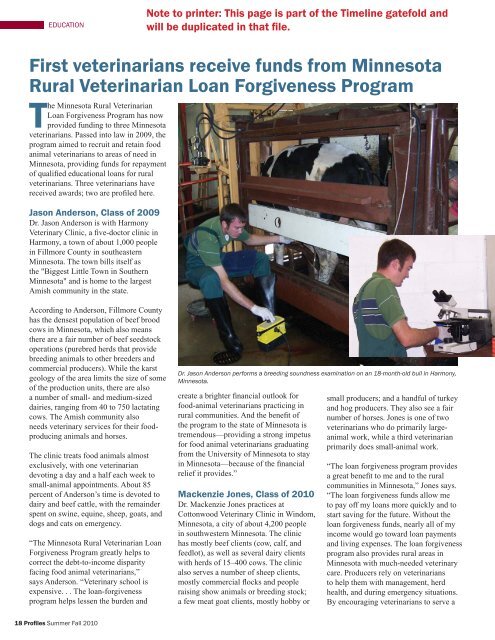Summer/Fall 2010 PDF Version - University of Minnesota College of ...
Summer/Fall 2010 PDF Version - University of Minnesota College of ...
Summer/Fall 2010 PDF Version - University of Minnesota College of ...
You also want an ePaper? Increase the reach of your titles
YUMPU automatically turns print PDFs into web optimized ePapers that Google loves.
EDUCATION<br />
Note to printer: This page is part <strong>of</strong> the Timeline gatefold and<br />
will be duplicated in that file.<br />
First veterinarians receive funds from <strong>Minnesota</strong><br />
Rural Veterinarian Loan Forgiveness Program<br />
The <strong>Minnesota</strong> Rural Veterinarian<br />
Loan Forgiveness Program has now<br />
provided funding to three <strong>Minnesota</strong><br />
veterinarians. Passed into law in 2009, the<br />
program aimed to recruit and retain food<br />
animal veterinarians to areas <strong>of</strong> need in<br />
<strong>Minnesota</strong>, providing funds for repayment<br />
<strong>of</strong> qualified educational loans for rural<br />
veterinarians. Three veterinarians have<br />
received awards; two are pr<strong>of</strong>iled here.<br />
Jason Anderson, Class <strong>of</strong> 2009<br />
Dr. Jason Anderson is with Harmony<br />
Veterinary Clinic, a five-doctor clinic in<br />
Harmony, a town <strong>of</strong> about 1,000 people<br />
in Fillmore County in southeastern<br />
<strong>Minnesota</strong>. The town bills itself as<br />
the "Biggest Little Town in Southern<br />
<strong>Minnesota</strong>" and is home to the largest<br />
Amish community in the state.<br />
According to Anderson, Fillmore County<br />
has the densest population <strong>of</strong> beef brood<br />
cows in <strong>Minnesota</strong>, which also means<br />
there are a fair number <strong>of</strong> beef seedstock<br />
operations (purebred herds that provide<br />
breeding animals to other breeders and<br />
commercial producers). While the karst<br />
geology <strong>of</strong> the area limits the size <strong>of</strong> some<br />
<strong>of</strong> the production units, there are also<br />
a number <strong>of</strong> small- and medium-sized<br />
dairies, ranging from 40 to 750 lactating<br />
cows. The Amish community also<br />
needs veterinary services for their foodproducing<br />
animals and horses.<br />
The clinic treats food animals almost<br />
exclusively, with one veterinarian<br />
devoting a day and a half each week to<br />
small-animal appointments. About 85<br />
percent <strong>of</strong> Anderson’s time is devoted to<br />
dairy and beef cattle, with the remainder<br />
spent on swine, equine, sheep, goats, and<br />
dogs and cats on emergency.<br />
“The <strong>Minnesota</strong> Rural Veterinarian Loan<br />
Forgiveness Program greatly helps to<br />
correct the debt-to-income disparity<br />
facing food animal veterinarians,”<br />
says Anderson. “Veterinary school is<br />
expensive. . . The loan-forgiveness<br />
program helps lessen the burden and<br />
Dr. Jason Anderson performs a breeding soundness examination on an 18-month-old bull in Harmony,<br />
<strong>Minnesota</strong>.<br />
create a brighter financial outlook for<br />
food-animal veterinarians practicing in<br />
rural communities. And the benefit <strong>of</strong><br />
the program to the state <strong>of</strong> <strong>Minnesota</strong> is<br />
tremendous—providing a strong impetus<br />
for food animal veterinarians graduating<br />
from the <strong>University</strong> <strong>of</strong> <strong>Minnesota</strong> to stay<br />
in <strong>Minnesota</strong>—because <strong>of</strong> the financial<br />
relief it provides.”<br />
Mackenzie Jones, Class <strong>of</strong> <strong>2010</strong><br />
Dr. Mackenzie Jones practices at<br />
Cottonwood Veterinary Clinic in Windom,<br />
<strong>Minnesota</strong>, a city <strong>of</strong> about 4,200 people<br />
in southwestern <strong>Minnesota</strong>. The clinic<br />
has mostly beef clients (cow, calf, and<br />
feedlot), as well as several dairy clients<br />
with herds <strong>of</strong> 15–400 cows. The clinic<br />
also serves a number <strong>of</strong> sheep clients,<br />
mostly commercial flocks and people<br />
raising show animals or breeding stock;<br />
a few meat goat clients, mostly hobby or<br />
small producers; and a handful <strong>of</strong> turkey<br />
and hog producers. They also see a fair<br />
number <strong>of</strong> horses. Jones is one <strong>of</strong> two<br />
veterinarians who do primarily largeanimal<br />
work, while a third veterinarian<br />
primarily does small-animal work.<br />
“The loan forgiveness program provides<br />
a great benefit to me and to the rural<br />
communities in <strong>Minnesota</strong>,” Jones says.<br />
“The loan forgiveness funds allow me<br />
to pay <strong>of</strong>f my loans more quickly and to<br />
start saving for the future. Without the<br />
loan forgiveness funds, nearly all <strong>of</strong> my<br />
income would go toward loan payments<br />
and living expenses. The loan forgiveness<br />
program also provides rural areas in<br />
<strong>Minnesota</strong> with much-needed veterinary<br />
care. Producers rely on veterinarians<br />
to help them with management, herd<br />
health, and during emergency situations.<br />
By encouraging veterinarians to serve a<br />
18 Pr<strong>of</strong>iles <strong>Summer</strong> <strong>Fall</strong> <strong>2010</strong>

















